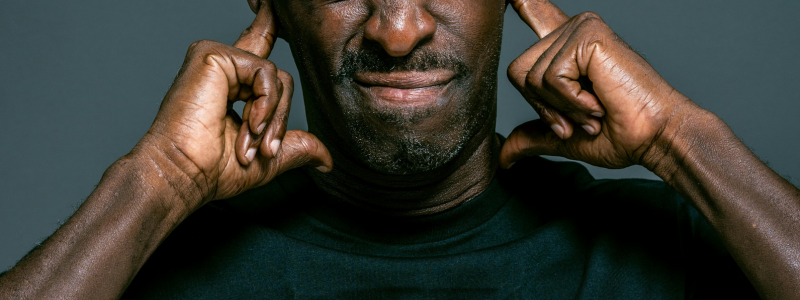
Head of Online Medical Content

Audiology Expert

What is Diplacusis?
Understanding why some hear different pitches or echoes
Overview | What is diplacusis? | The different types | The causes | The treatments | Summary
Last Hearing Aid UK Update:
Overview
Diplacusis, or "double hearing," is a rare condition where one sound is heard as two different pitches, often due to hearing loss or ear damage. It can affect one or both ears and may be linked to blockages, head trauma, or ototoxic medications.
Treatments like hearing aids, sound therapy, or clearing blockages can help manage or resolve symptoms.
What is double hearing?
When we think about how we hear, most ears work in sync, giving us sound as a unit to our brains. This is similar to our brain needing to merge what is seen by two eyes for a single image.
Even if our ears pick up slightly different pitches, our brains are still able to understand the sound's source.
When this doesn't happen, it's called diplacusis, or "double hearing", resulting in a two-sound experience.
In this article, we briefly go through the key symptoms, causes, treatment available, and what your next steps should be if you think you might be suffering from double hearing.
Main points
- Diplacusis is also known as "double hearing", considered rare, which means you can hear a single sound as two different pitches.
- Diplacusis usually affects those with hearing loss, especially asymmetrical hearing loss or ear complications.
- Treatments generally, at minimum, reduce symptoms or are known to stop them entirely.
- Musicians are at a higher risk of developing diplacusis due to being exposed to loud noises. This means their ears are more sensitive to both pitch and tone.
- With this lesser-known condition, the pitch, volume, or timing of a sound can be impacted.

Are there different types of diplacusis?
Those with diplacusis hear one single sound as two separate pitches, which can either be in addition to tinnitus (ringing of the ears) or experienced on its own.
A concerning condition for those affected, double hearing is usually caused by certain conditions, but the reality is that it can affect anyone.
You can experience diplacusis in one ear or both. If it is present in both, it is known as diplacusis binauralis or duplacusis monauralis when referring to just one ear. There are also different subtypes of diplacusis. These are:
- Diplacusis dysharmonica: Seen as the most common type of double hearing, and is when you don't struggle with timing, but you have problems with different pitches.
- Diplacusis echoica: This is when your ears hear sound at different speeds, often sounding like an echo.
Causes of diplacusis
Double hearing can be caused by taking medications that are known to damage the ear; these are called ototoxic drugs, along with the following:
- One ear is affected by hearing loss: There are two types of hearing loss that are strongly linked to diplacusis. One being asymmetrical hearing loss, when one ear is worse than the other.
The second is unilateral hearing loss (single-sided deafness), when you can hear normally in just one ear.
- Sensorineural hearing loss: This is recognised as the most common form of hearing loss, often due to exposure to loud noise or ageing, and it affects both ears in the same way.
- Blockages in the ear: If there are obstructions in the ear, it can alter how you interpret sound and ultimately impact your hearing. In most cases, if a blockage is removed, normal hearing can resume.
Examples of blockages could be an ear infection, excessive earwax, eustachian tube dysfunction, and acoustic neuroma.
- Trauma to the head or ears: Such injuries can affect the inner ear structures, like the cochlea and auditory nerve, which can impact how the brain processes sound.
Related reading: Sensorineural hearing loss
Diplacusis treatments
The treatment needed will depend on the cause, and in some cases, it might be simple to address.
For example, if your diplacusis is due to an obstruction, such as a buildup of earwax or fluid from an infection, your hearing usually returns to normal once the blockage is cleared or the infection resolves.
If your double hearing is connected to hearing loss, hearing aids could improve your ability to hear more clearly and balance the sound input between both ears.
Customised settings can be tailored to your specific hearing loss needs, helping to compensate for any imbalance in hearing between your ears.
In cases of severe or profound hearing loss, cochlear implants may be recommended as a solution.
Other approaches might involve auditory rehabilitation or training, which can assist your brain in adjusting to changes in sound perception.
Sound therapy may also help to desensitise you to various pitches, while cognitive behavioural therapy (CBT) could be used to manage the stress and anxiety that often accompany double hearing.
Summary
Diplacusis is a rare hearing condition where a single sound is heard as two different pitches. It’s often linked to hearing loss, ear blockages, or damage from loud noise or certain medications.
While it can affect one or both ears, treatments such as hearing aids, sound therapy, or medical intervention can help restore clearer hearing and reduce symptoms.
Why Choose Us?
- FREE Hearing Tests
- Best Hearing Aids and Prices
- FREE Aftercare for Life
- FREE Home Visits
- 200+ Local Audiologists
- 60 Day Money Back Guarantee
How to seek help for diplacusis
If you experience double hearing, it’s important to see an audiologist or an ENT doctor as soon as possible.
They will assess your symptoms and typically perform a hearing test to identify any underlying issues.
Additional tests, such as an auditory brainstem response (ABR) test, may also be done.
This is to check for potential problems with the inner ear or auditory nerve that could be contributing to the distortion.
Hearing loss awareness articles you might like...
 How Stress Affects Your Ears
How Stress Affects Your Ears  What is Earache and Pain?
What is Earache and Pain?  What is Swollen Ear?
What is Swollen Ear? Our specialist service includes:
Do not spend hundreds of pounds without getting a second opinion from us.
Please call us on 0800 567 7621
 Not only are the prices great, but the service is fantastic! Many thanks to your team.
Not only are the prices great, but the service is fantastic! Many thanks to your team.What's included in our hearing aid prices?
Other pages you might find useful
FAQs
In general, any audiologist will always recommend to you the hearing aid model that best suits your needs. Here is a useful checklist to make sure that is the case.
- Audiologist's level of knowledge: The audiologist you have seen will hopefully have a wide knowledge of all available hearing aids; however, some will only be familiar with a small number of brands and, therefore, may not really be in a position to know which model is the best for you. It is OK to challenge their recommendation and ask them to justify why this particular brand is the one for you.
- Do research: Read about the hearing aid that was recommended. Does it seem like it will suit your lifestyle? Does it have more or fewer features than you need?
- Be aware of sales targets: Many high street retailers have specific tie-ins to a particular manufacturer/brand. The hearing aid they have suggested may still be the correct one for you, but do your research so that you know why they might have recommended it.
If you have significant hearing loss in both ears, you should be wearing two hearing aids. Here are the audiological reasons why:
Localisation: The brain decodes information from both ears and compares and contrasts them. By analysing the minuscule time delays as well as the difference in the loudness of each sound reaching the ears, the person is able to accurately locate a sound source.
Simply put, if you have better hearing on one side than the other, you can't accurately tell what direction sounds are coming from.
Less amplification is required: A phenomenon known as “binaural summation” means that the hearing aids can be set at a lower and more natural volume setting than if you wore only one hearing aid.
Head shadow effect: High frequencies, the part of your hearing that gives clarity and meaning to speech sounds, cannot bend around your head. Only low frequencies can. Therefore, if someone is talking on your unaided side, you are likely to hear that they are speaking, but be unable to tell what they have said.
Noise reduction: The brain has its own built-in noise reduction, which is only really effective when it is receiving information from both ears. If only one ear is aided, even with the best hearing aid in the world, it will be difficult for you to hear in background noise as your brain is trying to retain all of the sounds (including background noise) rather than filtering them out.
Sound quality: We are designed to hear in stereo. Only hearing from one side sounds a lot less natural to us.
Fancy some further reading on this topic? You can read about why two hearing aids are better than one in our article, hearing aids for Both Ears, here
For most people, the main benefit of a rechargeable hearing aid is simple convenience. We are used to plugging in our phones and other devices overnight for them to charge up. Here are some other pros and cons:
For anybody with poor dexterity or issues with their fingers, having a rechargeable aid makes a huge difference, as normal hearing aid batteries are quite small and some people find them fiddly to change.
One downside is that if you forget to charge your hearing aid, then it is a problem that can't be instantly fixed. For most, a 30-minute charge will get you at least two or three hours of hearing, but if you are the type of person who is likely to forget to plug them in regularly, then you're probably better off with standard batteries.
Rechargeable aids are also a little bit bigger and are only available in Behind-the-Ear models.
Finally, just like with a mobile phone, the amount of charge you get on day one is not going to be the same as you get a few years down the line. Be sure to ask what the policy is with the manufacturer's warranty when it comes to replacing the battery.
For most people, the answer is yes. But it's never that simple.
The majority of hearing problems affect the high frequencies a lot more than the low ones. Therefore, open fitting hearing aids sound a lot more natural and ones that block your ears up can make your own voice sound like you are talking with your head in a bucket. Therefore, in-ear aids tend to be less natural.
However, the true answer is we can't tell until we have had a look in your ears to assess the size of your ear canal, and until we have tested your hearing to see which frequencies are being affected.
People with wider ear canals tend to have more flexibility, also there are open fitting modular CIC hearing aids now that do not block your ears.
There is also the age-old rule to consider, that a hearing aid will not help you if it's sat in the drawer gathering dust. If the only hearing aid you would be happy wearing is one that people can't see, then that's what you should get.
Most people can adapt to any type of hearing aid, as long as they know what to expect. Have an honest conversation with your audiologist as to what your needs are.
Generally speaking, six or more. Unless it's none at all. The number of channels a hearing aid has is often a simplistic way an audiologist will use to explain why one hearing aid is better than another, but channels are complex, and it is really not that straightforward. Here are some reasons why:
Hearing aids amplify sounds of different frequencies by different amounts. Most people have lost more high frequencies than low, and therefore need more amplification in the high frequencies. The range of sounds you hear is split into frequency bands or channels, and the hearing aids are set to provide the right amount of hearing at each frequency level.
Less than six channels, and this cannot be done with much accuracy, so six is the magic number. However, a six-channel aid is typically very basic with few other features and is suitable only for hearing a single speaker in a quiet room. The number of channels is not what you should be looking at; it's more the rest of the technology that comes with them.
As a final note, different manufacturers have different approaches. One method is not necessarily better than any other. For example, some manufacturers have as many as 64 channels in their top aids. Most tend to have between 17 and 20. One manufacturer has no channels at all.
Manufacturer's warranties typically last between 2-5 years, depending on the brand and model, and cover defects in materials and workmanship. This includes repairs for component failures, electronic malfunctions, and manufacturing defects, but excludes damage from misuse, accidents, or normal wear. Most manufacturers also include loss and damage insurance for the first year.
We handle all warranty claims on your behalf, liaising with manufacturers and ensuring you get replacement devices quickly when needed. This comprehensive warranty coverage, combined with our lifetime aftercare, gives you complete peace of mind.
Our hearing tests are completely free, whether at our clinics or in your home. Unlike other providers who charge £30-£100 for home visits, we believe hearing healthcare should be accessible without financial barriers. Our comprehensive assessments include examination by a registered audiologist, audiogram results, and personalised recommendations.
All testing, future adjustments, and ongoing support are included at no extra cost. While NHS tests are also free, typical 6-week waiting periods often lead people to seek immediate private testing. We provide prompt, professional assessments that fit your schedule and budget.
Yes, we offer completely free home visits throughout the UK, and this service is included in our prices with no additional charges. Home visits are particularly valuable for people with mobility issues, busy schedules, or those who simply prefer the comfort and convenience of their own environment.
Our audiologists can conduct full hearing tests, fit hearing aids, and provide ongoing support in your home. This service sets us apart from many providers who either don't offer home visits or charge extra for them.
We can offer prices up to 40% lower than high street retailers because of our business model. As a network of 200+ independent audiologists, we don't have the massive overheads of large retail chains - no expensive high street premises, no sales targets pushing audiologists to sell the most expensive options, and no costly marketing campaigns.
However, we maintain the same buying power as the big chains because we purchase on behalf of our entire nationwide network. This means you get access to the same premium hearing aids with professional service, but at genuinely competitive prices.
We offer a comprehensive 60-day money-back guarantee, which gives you twice the industry standard time to properly assess whether your hearing aids are right for you. This extended period recognises that adjusting to hearing aids takes time, and your brain needs several weeks to adapt to the amplified sounds.
Unlike many providers who offer just 30 days, we believe 60 days gives you the confidence to test your hearing aids in all the situations that matter to you - from quiet conversations at home to busy restaurants and outdoor activities.
Ask the Experts
6 Morton Lane
Walkwood
Redditch
Worcestershire
B97 5QA
Latest Launch
When we refer to a product as 'Latest Launch', we mean it is the latest to be released on the market.
New
When we refer to a product as 'New', we mean that the product is the newest hearing aid model on the market.
When we refer to a product as 'Superseded', we mean that there is a newer range available which replaces and improves on this product.
Older Model
When we refer to a product as an 'Older Model', we mean that it is has been superseded by at least two more recent hearing aid ranges.
